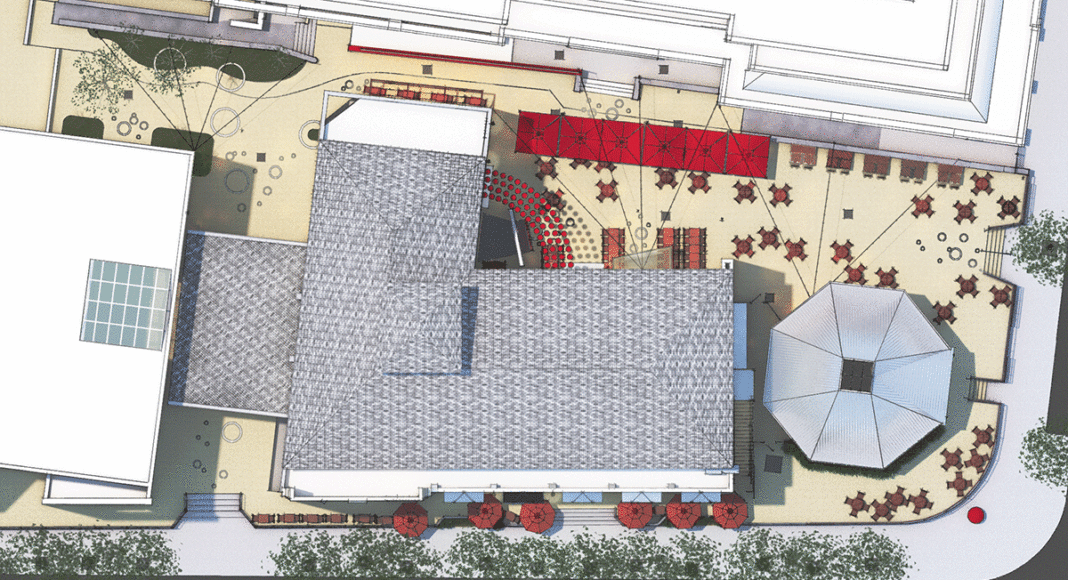A long-discussed vision for constructing the creative soul of downtown Santa Cruz at Abbott Square will finally be set in motion this spring.
“We’re talking about live music multiple nights a week, events and performances on a regular basis, yoga classes, reading programs for families with little kids—certainly all of the participatory art, history, and cultural experiences that people have come to expect from the MAH,” says Nina Simon, executive director of the Santa Cruz Museum of Art & History (MAH), who has spearheaded this project since its inception in 2012. She says the museum is bringing its “flavor” outside and inviting the community in.
The site off Cooper Street, which used to function as a quiet downtown pedestrian alley, will now be the museum’s “back porch, featuring open seating on an extended plaza for live performances and community events—as well a “secret garden” on the back plaza, boasting landscaping and creative activities designed with children in mind. MAH staff have been vague with details about the square, as they hope the grandeur of the project will speak for itself once it is revealed.
Developer John McEnery IV recently curated a diverse group of talented local chefs and vendors to staff the Abbott Square Market, which will have five mini-restaurants and two bars. The square will be open to the public from 6 a.m. to 10 p.m., Monday through Friday, and will stay open until midnight on weekends.
Abbott Square’s latest challenge is figuring out what to do with the Octagon building that used to be home to Lulu Carpenter’s coffee roasters. The coffee shop moved out of the historic location, which once served as the county’s hall of records, at the end of October, and the building is currently vacant, an unexpected twist for the MAH, although museum leaders have decided to include the 134-year-old building in their Abbott Square vision. Right now, the developers are extending an invitation to the public for the opportunity to use the Octagon as a pop-up creative or cultural experience. Open houses will be held at the space in early January, and proposals for the Octagon’s first pop-up are due Jan. 22. “It could be creative retail, it could be workshop space, it could be a gallery, we don’t know. We’re leaving it open to the community right now,” says Simon.
Planning for the $5 million Abbott Square project began in 2012, the year after Simon took over as the MAH’s director and saw an opportunity almost immediately.
The desire for a bustling creative hub downtown in a city known for its artistic talent dates back a couple decades to the 1989 Loma Prieta Earthquake—whose most notable architectural casualty, the Cooper House, had been home to restaurants, shops, live bands and dancing. A wrecking ball leveled what was left of the building in the weeks after, and over the years, people discussed how to recreate that feeling of community space downtown. Many wanted a plaza, focusing on a lot owned by Louis Rittenhouse on Pacific Avenue (now home to a Rip Curl store). But even if Rittenhouse had agreed to sell, activists and city planners were having a hard time agreeing on how to use the parcel anyway, and the discussion eventually quieted.
All the while, Abbott Square—named after Chuck and Esther Abbott, whose vision helped shape the previous Pacific Garden Mall—sat quietly behind the Cooper House, which got rebuilt and filled with new shops like O’Neill.
Ann Ostermann, open studios and events manager for the Santa Cruz Arts Council, says sometimes it takes a “visionary” like Simon to see the obvious—in this case, that the atmosphere the Cooper House provided had never been replaced and that Abbott Square, if invigorated, could fill that void.
Around the time of Simon’s hiring nearly six years ago, the museum was discussing ways to renew its energy and evolve into a cultural center for the community. Simon saw Abbott Square, which was nothing more than an open patio and a coffee shop, as the museum’s link to the unique downtown around it, and saw the potential for reviving the MAH’s spirit to also revive the community outside—something the arts community appreciates.
“It’s great for us to have a place where there’s people and there’s music, and there’s so much action. And of course, we’re crazy about everything the MAH’s doing,” says Ostermann, who says it was a “sad day” when the Cooper House came down 27 years ago. “The square will have a flow to it, because there are going to be different projects. It’s going to be shifting and moving, and I really like that.”
Museum leaders raised funds for Abbott Square primarily through community contributions. The MAH received $1 million dollars through grants from foundations, and the rest came from local businesses and individuals. Although the project is now fully funded, the MAH is still asking for donations to support events and performances at the square, which will be free and open to the public. Simon says the outpour of community support the project has received is encouraging her every step of the way.
To Simon, a successful Abbott Square is one that attracts everyone. The MAH, she says, not only hopes to enliven the community, but help it heal as well. Lively and energetic public spaces that allow people to feel comfortable and included are proven by urban planners to attract positive behaviors, she says, and deter things like criminal activity and harassment.
The square is providing an interesting spin on art, too.
“It’s bringing art outside. People still have such an ordinary idea of what a museum is,” says Ostermann, who adds that the Arts Council has been working on similar goals, both at the Tannery Arts Center and through the Ebb and Flow projects along the levee. “I like the idea of people experiencing art outside, as well as inside.”
For information on how to pitch a program or project for the Octagon, visit www.abbottsquare.org.












